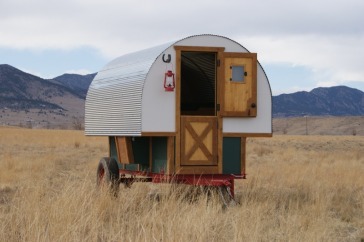The History of the Sheep Wagon

The Sheep Wagon is a spectacle of practicality and compactness. The interior arrangement has proven efficient for over one hundred and twenty years. The Sheep Wagon as we distinguish it today originated in Wyoming along with the developed sheep industry during the 1870’s. The basic floor plan of the “camp” has seen little change since the original design. A “Sheepherder” followed bands of sheep to watch over them. The herder needed protection on the open range from the harsh Wyoming winter weather. The nomadic sheepherder followed the sheep into remote locations and needed a “home on wheels”. By 1910, Wyoming boasted more than 5 million sheep. With one herder able to care for as many as 3,000 sheep it is feasible to say that by the height of the sheep industry there could have been as many as 3,000 sheep wagons in Wyoming alone. It has been reported by “old-timers” that one could see a sheep wagon on every hill top on the winter range. Time and modern convenience has changed many things including the way of the traditional sheepherder. A rancher could fence large tracts of land and more easily check his flock with a modern four-wheel drive vehicle. The pick-up truck had an enormous impact as it replaced the team of horses that pulled the wagon. The truck however did not eliminate the need for someone to watch over the flock, but it did make it more convenient to pull a wagon from one spot to another. Rubber tires replaced wooden wheels and sheet metal replaced the original canvas covered top. Whether by design or accident, the sheep wagon retained its original interior configuration because the space worked so efficiently. Even though a lot less today, sheep wagons are still being used by herders in Wyoming, Colorado and Utah. But you are more likely to spot one of these historic marvels restored and used as a guest room, an office or a distinctive yard ornament.
Like an old west gun fighter represents an earlier time and culture, not to mention an imperative part of history; the Sheep Wagon represents a symbol of a significant cultural artifact of the historic sheep industry.